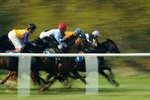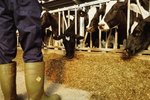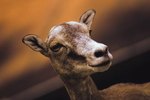Fitting a steer for show is a time-consuming process that requires daily effort on the part of his owner. A good grooming job emphasizes the steer's conformation and draws the discerning eye of the judge away from minor flaws. Fitting techniques may differ depending on the length of the steer's hair and the grooming standards for the breed.
Good Beginnings
Acclimate show steers to fitting techniques from a young age. Once a calf is accustomed to the halter and lead rope, you can tie him to a fencepost with his head up for a short period of time -- no more than 20 minutes, according to the American Angus Association. Scratch his belly with a show stick to get the calf to lift his back, or topline. The calf's front feet should be squarely beneath his body, creating a straight line from shoulder to ground, and his hind feet set at a slight angle with the leg farthest from the judge slightly farther back.
Good Nutrition
Invest in a high-quality diet for show steers; a healthy coat grows quickly. Feed oats, soybean meal and corn for protein, and vitamin A supplements, iodized salt and cottonseed oil for oil retention in the coat. Feed-grade limestone serves as a calcium supplement, alone or mixed with salt in a 1-to-1 ratio. Alfalfa pellets provide both calcium and protein, making them a convenient, natural choice of feed for show steers.
Best Brushing Practices
Regular brushing helps stimulate hair growth, particularly during summer months. Once the steer is clean, remove excess water from his coat with a comb, working back to front and in a downward motion. Remove curls with the comb, and comb the hair toward the neck and shoulder. On long-haired breeds, brush the body at a 45 degree angle and the hair on the legs straight forward.
Bathing Steers
A daily rinse with mild soap and lukewarm water will keep dirt from accumulating in the steer's coat, as well as keep him free of external parasites. Use shampoo sparingly, or it could damage the hair and cause it to fall out, according to Kirk Stierwalt, the cattle-grooming training adviser for Andis, a clipper manufacturer. Blow-dry the damp steer every day to stimulate hair growth and train the hair to lie flat in one direction.
Clipping Show Steers
You need several types of clippers to groom a steer, and you need experience. Let an agriculture studies adviser or another professional clip your steer, and ask him to teach you the proper use of the tools. You need to become familiar with the steer's mannerisms and his anatomy. Clipping against the grain of the hair helps attain a smooth appearance; knowing the animal's contours is key. You'll clip most parts of the body, including the tail, legs, belly, brisket, head and face, to established standards that you'll need to study. Hair behind the shoulder and on top of the poll is usually left alone. Overall, the clipping should accentuate the steer's natural muscle and preserve as much hair as possible to create the illusion of volume. You'll have opportunities to trim the steer for practice, and you'll want to be practiced two weeks to 10 days before a show.
Last Minute Preparations
Don't feed your steer the morning of departure for the showing venue. When he arrives at the venue, feed half his usual ration. Two hours before the start of the show, bathe, dry and feed the steer. You can apply hair-conditioning polish to the steer's clean coat; blow-drying will keep his hair in place. Prepare the steer's legs by spraying adhesive and then combing the tacky hair in a forward and upward motion. At the last minute, spray a light mink oil or finishing spray onto the steer's coat to polish his hair further. Following the show, wash the steer again with a shampoo that will remove the oil and adhesive; outfitters and supply companies sell products specifically for removing show-day substances including adhesives, lacquers and paints.
References
- The Judging Connection: Beef Grooming, Fitting and Showmanship
- Andis Clipz: Grooming Cattle for Show: A Beginner's Guide
- Chico State College of Agriculture Sheep & Goat Unit: Successful Fitting and Grooming of Beef Cattle
- The Fence Post: The Art of Grooming Show Cattle
- Agriview: Fitting & Showing: Tips and Tricks for First-Time Fitters
- American Angus Association: Showring Success: Presenting Your Animal
- Ohio State University Extension: Feeding the Show Steer
- UNL Extension in Phelps University: Calf Club Management Guide
Photo Credits
-
Peter Dean/iStock/Getty Images




